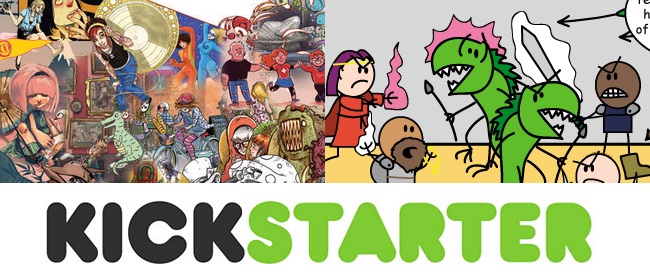
So you have an awesome idea for a comic, you’ve got a kick-butt creative team, and you’re just crazy enough to think it’s a good idea to take your comic to Kickstarter, the foremost crowd-funding platform on the Internet. First, congratulations: your chances at success are probably better than you think. Second, good luck.
Kickstarter brings with it plenty of opportunity, to be sure. IDW’s Womanthology picked up $109,301 in 2011, and a campaign for the webcomic Order of the Stick garnered a staggering $1.25 million in Kickstarter-based pre-orders a year later–for a reprint. And those aren’t necessarily isolated cases. Statistically speaking, your chances of meeting your goal if you decide to seek funding for your comic through Kickstarter are slightly less than fifty-percent. Think about that: At a time when well over 90% of submissions to the largest indie publishers are rejected, Kickstarter gives you almost even odds of success. That’s surprisingly awesome.
Still, don’t expect it to be a cakewalk. If you manage to meet your funding goal, it’s going to be the result of a lot of hard work, but the hardest part of your Kickstarter campaign just might come after it’s over. In this blog post, I’m going to break down the costs and complications of fulfilling orders and delivering rewards to Kickstarter backers. For our purposes, we’ll leave creative costs and page rates aside for the moment and I’ll assume that you have a creative team already on board.
The first thing to cover, of course, is the cost of printing. Since few comics manage to gain much of an audience if they’re digital-only, this is the first of many costs that there’s no real way around. Well, not to worry. Marvel and DC print comics every week, and things seem to run smoothly, for the most part. All I need is the cash to cover it, and that’s what Kickstarter is for. No problem, right?
Unfortunately, it’s not quite that simple. Comics from larger publishers are, on a per-copy basis, cheaper to manufacture and distribute at almost every stage. In practical terms, what that means is this: Instead of printing 50,000 copies on a wholesale basis for roughly 40-60 cents per copy, creators are ordering a few hundred copies (a thousand or more if they’re very lucky) through a printing service like Kablam or Lulu for about… how much, again?
Well, here’s some info on Lulu. These numbers date back to May 2012, but those I’ve talked to say little has changed. Their standard price to print a 22-page comic (black-and-white interior, full-color cover, mid-quality paper; short run) is $2.69 per copy. Now, if a creative team happens to be very, very successful in their campaign, and winds up with 2,500 copies or more to print, they might be able to get a decent price (60-70 cents per copy) from a company like Morgan Printing that specializes in short runs. That’s a number quoted by Evil Twin Comics’ Ryan Dunlavey. Evil Twin is a company founded by Fred van Lente, a person who most Kickstarter creators… well, aren’t.
Print-on-demand services are generally cheaper than full-scale offset printers until you hit big numbers. For either, $1 to $1.50 per copy is about standard in the 1,000-5,000 copies range. But, considering the humbler success of the average Kickstarter campaign, Lulu’s $2.69 is probably closer to average. That’s a number that would give the Big Two’s distribution specialists aneurysms, and that’s before shipping.
Speaking of shipping, that’s one topic probably worth a brief aside here, as it is the single biggest headache you will face when it comes to fulfilling orders. Not only are creators paying their printer to ship them the copies; fulfilling a Kickstarter campaign also means paying a second round of shipping costs to distribute those copies, one at a time, to backers. Printer-to-creator shipping is bad enough, but with a second shipping process involved, Kickstarter creators are effectively covering the price of distribution twice for every single copy–something even most small publishers haven’t dealt with in their worst nightmares. And unlike printing, shipping is one cost that doesn’t decrease with larger quantities.
I could go on for a while; the additional costs and customs problems posed by international shipping could fill an entire article of their own. Don’t let all this discourage you, though–Kickstarter is probably the single most promising resource currently available to aspiring creators. If you have the creativity and the dedication necessary, you owe it to yourself to give it a shot. Your chances of succeeding are almost great.













